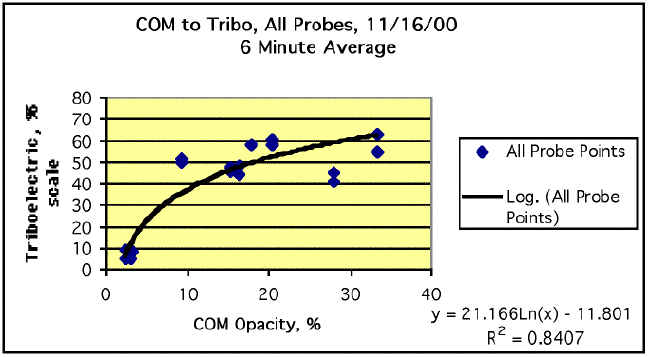


| Particulate | 10% | 25% | 50% | 75% | 90% |
| EAF dust, µm | <1.235 | <1.581 | <1.874 | <2.107 | <2.276 |
| Fe2O3, µm | <1.022 | <1.328 | <1.780 | <2.346 | <2.819 |

| Test #1 Probe A-1 to COM: | y = 1.878x + 22.485 R2 = 0.4054 |
| y = 24.205Ln(x) - 7.1213 R2 = 0.5782 | |
| Test #2 Probe A-1 to COM: | y = 0.7932x + 31.156 R2 = 0.3311 |
| y = 22.549Ln(x) - 13.203 R2 = 0.7056 | |
| Test #3 Probe A-2 to COM: | y = 1.4231x + 8.8582 R2 = 0.8854 |
| y = 21.934Ln(x) - 17.881 R2 = 0.9282 | |
| Test #4 Probe A-2 to COM: | y = 1.8411x + 13.226 R2 = 0.7561 |
| y = 24.875Ln(x) - 17.229 R2 = 0.9070 | |
| x = COM Opacity, % | |
| y = Triboelectric Signal, % scale |

| Probe B-2 | y = 1.479x + 18.723 |
| Probe A-2 | y = 1.562 x + 14.806 |
| Probe B-1 | y = 1.0083 x + 31.33 |
| Probe A-1 | y = 0.71393 x + 31.735 |
| Where: | x = COM opacity, % |
| y = Triboelectric signal, % of scale |
| Probes Groups: | A-1, B-1 | A-2, B-2 |
| Normal Operating Range: | 0% to 29% | 0% to 24% |
| Caution Range: | 30% to 37% | 25% to 29% |
| Alarm Range: | > 38% | > 30% |


